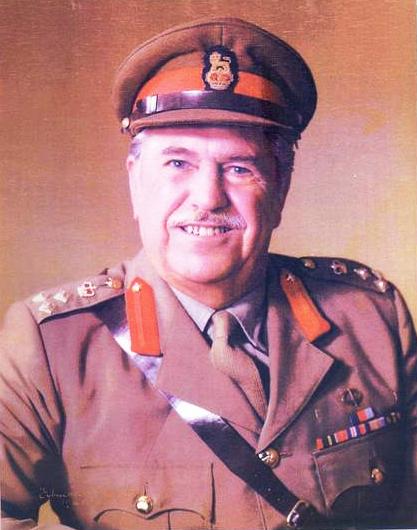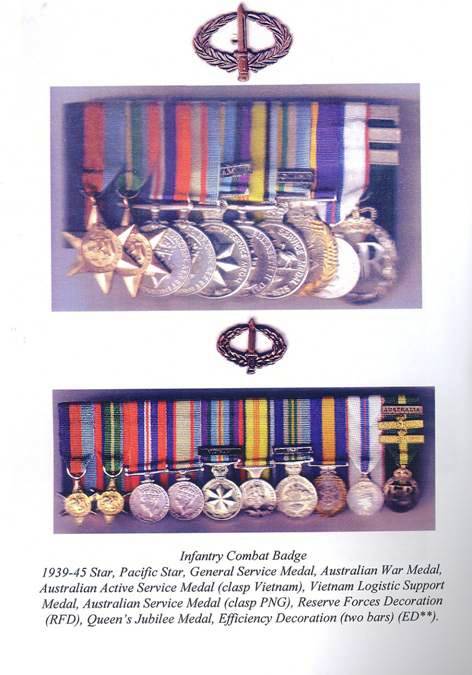by Joel M Barnett
Barrister at Law
Trustee, 9th Battalions War Memorial Museum
Collection and Property Trust
Brigadier Tom had many titles and civil academic awards for
his many achievements. His military awards were for either long, meritorious
service or actual service. He reached the first level of general officer rank.
At one time the Australian Army title for his rank was “Brigadier General” and
in fact it still is that in the US Army and US Marines Corps. He loved to say
that his ED (EFFICIENCY DECORATION) was for “20 years undetected crime as an
officer”.

However in his own words in his private autobiography he wrote:“ The one thing I wear most proudly on my uniform above my
medals, is a small bronze badge, just an oval oak leaf garland with a bayonet
in the middle – my Infantry Combat Badge. It means nothing to anyone other than
a soldier. but to other servicemen it signifies that I had been engaged in
Infantry combat, and that, I think says it all. It distinguishes us, as my late
father-in-law, Bob Brown, so succinctly put it, ‘from the ithers’.”
The other badge he took great pride in was his RSL badge,
which he always wore on his suit. He was the president of the Sandgate Sub
Branch, and the military history display which he established led the Commander
of the First Military District Brigadier (later Major General) Peter Phillips
MC to invite him to chair a Victoria Barracks museum, of which I had the honour
to serve at one time as his Vice President. He guided this group through
difficult times.
Likewise as he rose from a lowly clerk in the Maryborough
Courthouse to Solicitor General and consequently the most senior barrister on
the Roll in 1972, he similarly rose from a private soldier on the parade ground
to a brigadier, acting deputy divisional commander. His military career peaked
in the Army Reserve when his full time job was the onerous office of Solicitor
General for Queensland. His intermediate jobs and military appointments were
also what many men would have regarded a good career pinnacle. A monumental
effort considering that both ultimate jobs were at the peak of the pyramid.
Indeed a Rigby cartoon in the Telegraph upon his appointment as SG showed a
general in uniform and robes reviewing a parade of barristers…Rigby had been a
gunner in WW2. Brigadier Tom had Rigby’s original in his study.
He drew on his military experience in his role as a
Barrister quite often. He told me he likened a heavy criminal trial to have the
same strain and pressure that he experienced in a platoon attack. Indeed when
he and the late Justice George Lucas planned the Bar Practice Course at the QUT
for potential baby barristers they modelled the course on a direct entry
Officers “Knives and Forks” Course so at least they would know how to do their
job in the transition from student at law or solicitor to practice at the Bar.

Brigadier Tom joined the Militia in 47 Battalion at
Maryborough in the beginning of 1940; he was soon commissioned as a lieutenant.
At one stage he qualified in infantry anti tank tactics with 2 pdr guns being
trained by 101 Tank Attack Regiment RAA. Later in the war the infantry took
over the 2-pdr s and Lt Tom had to demonstrate the use. He fired 4 rounds off
and smote down a tree with a dexterity that the senior officers admired. When
packing up he found the axe, which one of his sergeants had used to “prepare”
the tree with a few cuts, was missing, they eventually found the axe after a lot of effort…axes had to be
meticulously accounted.
On another occasion he found out that there were rare fresh
rations including fruitcake available from LST’s when his unit was on the
Butibon River in New Guinea. He told his CO. As his battalion was on bully beef
and biscuits the QM was sent down to draw fresh rations, but was told politely
to come back next month as the unit had drawn it months rations. A mystery
10-wheel truck driven by an officer who smoked a pipe arrived at the ration
point with an impeccably correct requisition. The identity of the persons
involved was never found. In his memoirs Brigadier Tom said that many people
knew what was going on and there was tight knit solidarity. He had a lot of
trouble driving a left-handed drive truck for the first time.
During another course in WW2 he was in a group who were
demonstrated a prototype .45 calibre Sub Machine Gun by Evelyn Owen, it was an
early Owen Gun which later had a production calibre of 9mm. He was in
Townsville for a while early in the war but then went on to New Guinea where he
saw extensive service as a platoon commander. It was in New Guinea he first
smoked his trademark pipe.
He had asked his father in law for a pipe and was sent a supply of tobacco in a
tin with a small GBD silver mounted pipe. This later saved his life when it was
in his shirt pocket and stopped a Japanese bullet and he once remarked:
“ I owe a lot to my pipe, I could never get another as good
as that one.” No one could, I suggest!
His active service was not only in World War Two but
benignly in the Vietnam War. He like many CMF (Reserve) officers were sent for
a two week observer stint, for which he later received a further active service
gong. He remarked to me that he wished he’d earned his Pacific Star as easily
as that one.
After World War Two he married his beloved Margaret in 1946.
Like many returned solders he married in uniform whilst awaiting discharge. As
part of his resettlement he enrolled in the TC Bierne School of Law at the
University of Queensland to read for an LLB. Thus there is a direct link
between his legal and military careers. In 1949 he joined the newly formed
Citizens Military Forces and was promoted a captain in infantry. In 1956 the
Queensland University Regiment was raised to battalion status and Brigadier Tom
was appointed to command as a lieutenant colonel a post, which he held until
1959. That did not end his association with QUR however because in 1976 he had
the privilege of being QUR’s Honorary Colonel until 1980.
In the mid 1960’s he was 2 IC of the 1st Pentropic
Battalion. This was an experiment in formational use of infantry, and also the
other Corps using a US model. I Bn was under the command of a full colonel.
After three years he was promoted to full colonel, as Commander 2 Support
Group, which was a logistical, command encompassing Engineers. Ordnance, Army
Service Corps, Medical, Intelligence, WRAACS, Dental and Field Hygiene. He was
proud of the very great achievement that the medical units under his command
set up and manned “ the very fine Australian Military Hospital in Vietnam”
In 1972 he was appointed as Commander 7 Task Force and
promoted to the rank of brigadier. He was later appointed as acting Deputy
Divisional Commander I division, and retired in that office in 1975.
I mentioned his service to the RSL. Not surprisingly he held
high office in that organization, being a South East District’s Counsellor and
a State Counsellor for many years. As well as Sandgate Sub Branch President, he
was president of the Club and pulled that club out of a massive debt and on to
a very good profit.
I valued his guidance and friendship greatly. He moved my
admission and loaned me his wig until I acquired one myself. We spoke often.
His mind was always as sharp as a tack.
Like many of his military peer group he studied Confederate
Lieutenant General Stonewall Jackson’s Shenandoah Valley campaign ad nauseum
and General Jackson’s’ last words as he was dying from pneumonia were:
“Let us cross over the river and rest under the shade of the
trees.”
Brigadier Thomas Parslow RFD, ED**, QC soldier, lawyer and
advisor to statesmen, has crossed over the river and is now resting under the
shade of the trees.
As he often said at his RSL functions, “LEST WE FORGET”.